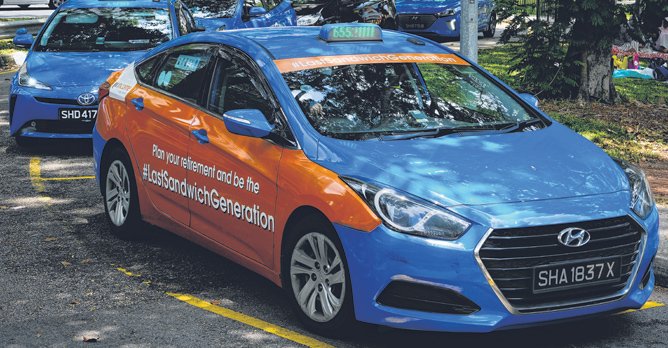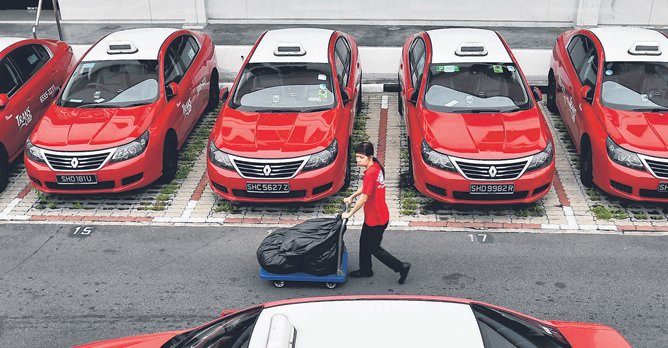Point-to-point regulatory framework to kick in by late October
01 Oct 2020|1,947 views
A long-delayed regulatory framework to level the playing field between cabbies and private-hire drivers will kick in soon.
Asked for an update on the regulatory framework for the Point-to-Point (P2P) transport sector, the Land Transport Authority (LTA) said it would start later this month.

The framework was to have taken effect by June this year. But because of the COVID-19 crisis, which has disrupted transport demand, it was postponed to last month, and then to this month. The Straits Times understands that the framework will take effect in the latter half of the month.
With it, operators will incur licensing fees that are pegged to their respective revenue. For a street-hail service licence, which allows drivers to pick up passengers on the street, the fee is 0.3% of the licensee's gross annual revenue.
For a ride-hailing licence, which restricts a licensee to only phone-hailed rides, operators are to pay a fee equivalent to 0.6% of their gross revenue. While the framework is expected to address an uneven playing field, stakeholders and observers reckon more can be done.

She said child seats should also be a requirement for both private-hire cars and taxis. They are currently not required for the latter.
Addressing the anti-competitive clause of the framework, Grab said the "current inconsistency whereby taxi operators can restrict their drivers from taking fixed-fare jobs on other platforms" should be addressed "as soon as possible".
Singapore University of Social Sciences Transport Economist Walter Theseira said, "The most important thing about the P2P framework is that, in principle, it gives LTA similar powers over both taxi operators and private-hire firms." But Associate Professor Theseira said the framework does not level the playing field completely.

This becomes a big sticking point "when you have a big downturn like this", Prof Theseira added. "For the same reason, when there is a sharp recovery, private-hire fleets can expand quickly, but taxis can't unless the regulatory framework becomes more flexible."
Mr. Ang Hin Kee, adviser to the National Taxi Association and the National Private Hire Vehicles Association, said companies should go beyond their business of matching drivers to passengers. "Take up the responsibility of helping drivers with their Medisave, retirement and training needs," he suggested.
He said that while drivers are not employees, they are key to the success of these businesses. "Platforms need to work with car rental companies to ensure that they cannot disassociate themselves from responsibilities to the drivers just because one leases the car and the other matches passengers." Mr. Ang said ride-hailing platforms should also "level up" their contribution to the financial aid given to drivers during this pandemic.
A long-delayed regulatory framework to level the playing field between cabbies and private-hire drivers will kick in soon.
Asked for an update on the regulatory framework for the Point-to-Point (P2P) transport sector, the Land Transport Authority (LTA) said it would start later this month.

The framework was to have taken effect by June this year. But because of the COVID-19 crisis, which has disrupted transport demand, it was postponed to last month, and then to this month. The Straits Times understands that the framework will take effect in the latter half of the month.
With it, operators will incur licensing fees that are pegged to their respective revenue. For a street-hail service licence, which allows drivers to pick up passengers on the street, the fee is 0.3% of the licensee's gross annual revenue.
For a ride-hailing licence, which restricts a licensee to only phone-hailed rides, operators are to pay a fee equivalent to 0.6% of their gross revenue. While the framework is expected to address an uneven playing field, stakeholders and observers reckon more can be done.

She said child seats should also be a requirement for both private-hire cars and taxis. They are currently not required for the latter.
Addressing the anti-competitive clause of the framework, Grab said the "current inconsistency whereby taxi operators can restrict their drivers from taking fixed-fare jobs on other platforms" should be addressed "as soon as possible".
Singapore University of Social Sciences Transport Economist Walter Theseira said, "The most important thing about the P2P framework is that, in principle, it gives LTA similar powers over both taxi operators and private-hire firms." But Associate Professor Theseira said the framework does not level the playing field completely.

This becomes a big sticking point "when you have a big downturn like this", Prof Theseira added. "For the same reason, when there is a sharp recovery, private-hire fleets can expand quickly, but taxis can't unless the regulatory framework becomes more flexible."
Mr. Ang Hin Kee, adviser to the National Taxi Association and the National Private Hire Vehicles Association, said companies should go beyond their business of matching drivers to passengers. "Take up the responsibility of helping drivers with their Medisave, retirement and training needs," he suggested.
He said that while drivers are not employees, they are key to the success of these businesses. "Platforms need to work with car rental companies to ensure that they cannot disassociate themselves from responsibilities to the drivers just because one leases the car and the other matches passengers." Mr. Ang said ride-hailing platforms should also "level up" their contribution to the financial aid given to drivers during this pandemic.
Latest COE Prices
April 2025 | 2nd BIDDING
NEXT TENDER: 07 May 2025
CAT A$99,500
CAT B$117,003
CAT C$65,001
CAT E$118,001
View Full Results Thank You For Your Subscription.




















